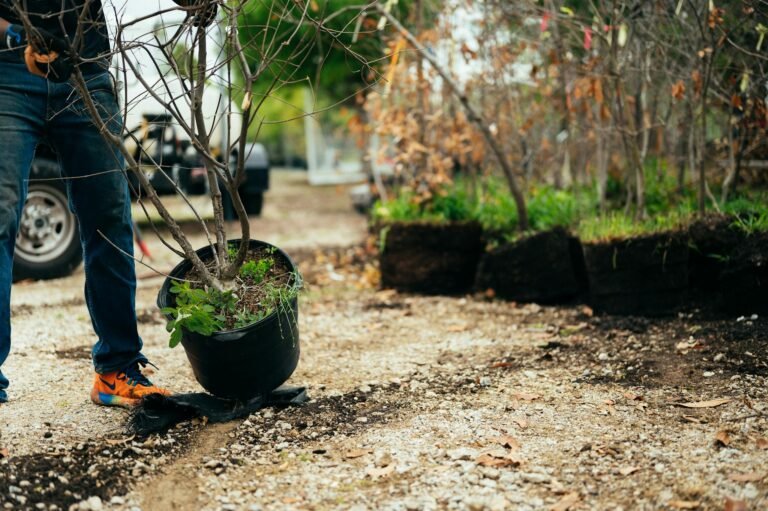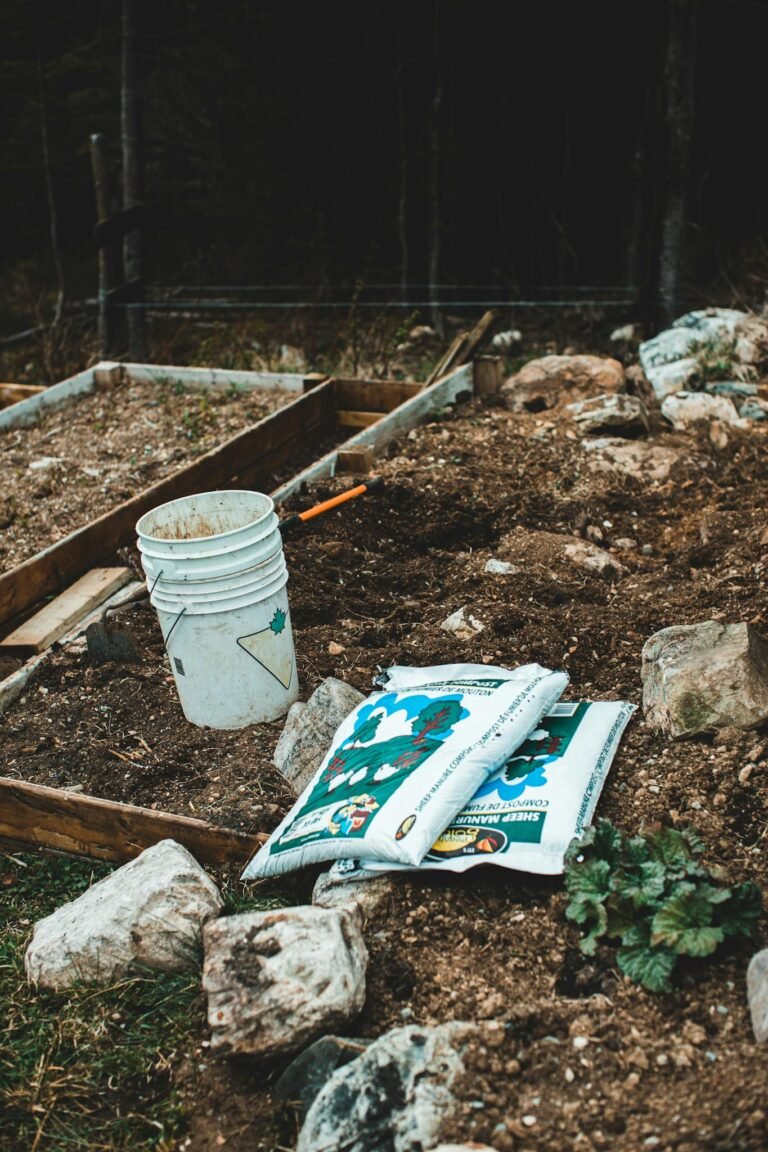Vertical garden walls are not just for big gardens. They can change any space. Apartment dwellers and homeowners alike can turn blank walls into green, living spaces. These walls can hold everything from tough succulents to lush ferns, fitting any climate.
Imagine a Melbourne courtyard full of 30 plant species or a Sydney wall covered in red bromeliads. These examples show how versatile and useful vertical garden wall ideas can be.
Vertical gardens do more than look good. They clean the air, reduce noise, and make us feel better. In cities, they can even add privacy with climbing plants. For indoor spaces, they can bring fresh herbs right to your kitchen.
Even beginners can start with systems like the Skale Greenwall. Whether you want a bold statement or a peaceful spot, these ideas can turn walls into living green spaces.
Key Takeaways
- Vertical gardens save space while improving air quality and mental health.
- They work indoors or outdoors, from succulent walls to herb-filled planters.
- Systems like Skale Greenwall simplify installation for even large-scale projects.
- Plant choices like clematis or echeveria match sunlight, water needs, and style.
- Repurposed materials—like pallets or bamboo—lower costs and add eco-friendly flair.
Understanding the Vertical Garden Wall Trend
Vertical garden walls are more than a modern trend—they have historical roots. Ancient civilizations like Babylon inspired today’s living walls. These green walls now bring fresh air and style to tight spaces in cities.

“Air-purifying green walls in offices have improved workers’ skin health and immunity, while their calming effect explains their popularity in wellness spaces.”
The History of Vertical Gardening
Vertical gardening has come a long way from ancient times. Early examples used gravity-defying terraces. Today, we use recycled materials like pallets or stacked pots. This turns walls into green canvases.
Environmental Benefits of Vertical Gardens
Green walls clean the air by absorbing pollutants. Plants like aloe and spider plants act as natural filters. They also reduce heat absorption, lowering energy costs.
Plus, their dense foliage muffles noise and supports local pollinators.
Space-Saving Advantages for Urban Dwellers
In cities, vertical garden wall ideas transform small spaces. Vertical gardening tips like choosing shallow-rooted herbs (mint, basil) or trailing flowers maximize yield. Even small balconies can host lush displays using hanging baskets or repurposed containers.
These systems also save water—drip irrigation lets moisture cascade downward, hydrating multiple plants. Whether for beauty or function, vertical gardens unlock big possibilities in small spaces.
What You Need to Know Before Starting Your Vertical Garden Wall
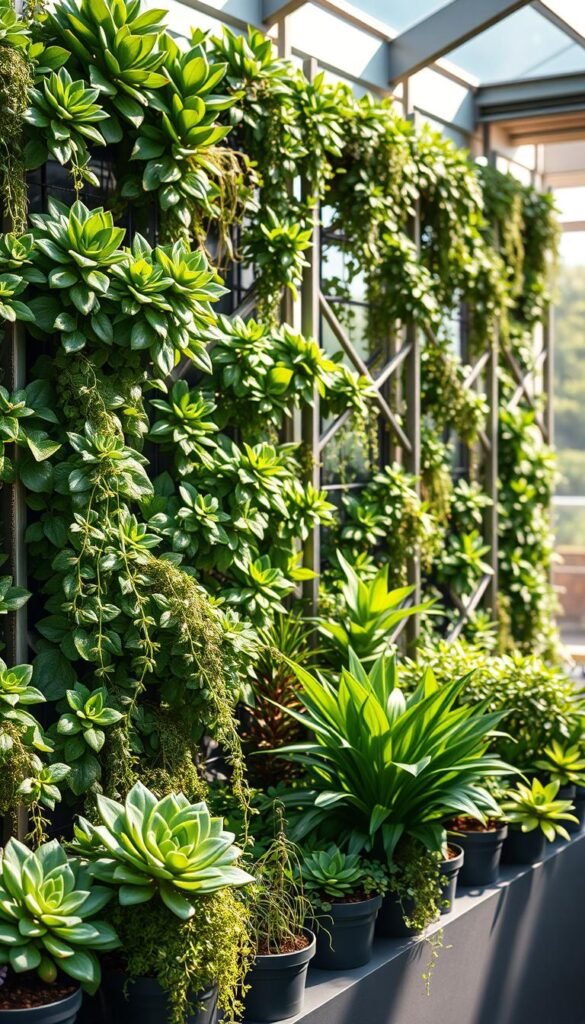
Before starting your vertical garden, take a few steps to ensure success. First, check your space’s natural light. Use a light meter app or track sunlight to find the best spot. Remember, “Right plant, right place” is key for plant health.
“The keys to a successful vertical garden are enough growing media and efficient watering.”
Assessing Your Space and Light Conditions
- Measure wall dimensions to match plant container sizes.
- Identify shade vs. sun exposure zones for plant selection.
- Avoid overhangs that cast shadows during peak growing hours.
Understanding Weight and Structural Requirements
Check your wall’s load capacity—soil and water add weight. Use lightweight materials like coconut coir instead of heavy clay. Make sure to have drainage holes to prevent waterlogging. For outdoor use, galvanized brackets are a good choice.
Planning Your Watering System
Choose drip irrigation or soaker hoses for even moisture. Timers help save time and prevent drying out. Use layered soil mixes with perlite for better drainage. Avoid overhead sprinklers to prevent runoff.
Follow these tips to avoid costly mistakes. Start small when learning to build a vertical garden. Focus on drainage, light, and support systems for healthy plants.
Indoor Vertical Garden Inspirations
Turn empty walls into lush green spaces with indoor vertical garden setups. They fit any room and mix beauty with practicality. Think fresh herbs, air-purifying plants, or artistic arrangements that fit your lifestyle.
- Living Room Statement: Hang modular panels from brands like Wayfair or Amazon with trailing plants like philodendron. Brighten corners with vibrant blooms like trailing ivy or calathea.
- Kitchen Herb Haven: Install pocket planters on pantry walls for basil, thyme, and rosemary. Repurpose a ladder from Home Depot as a vertical herb rack.
- Bathroom Oasis: Ferns and moss thrive in humid environments. Use moisture-resistant systems like Etsy-sourced felt pockets for a jungle vibe.
- Bedroom Serenity: Choose calming plants like lavender or snake plants. Preserved moss walls from EcoGreen Walls offer greenery without daily upkeep.
- Office Boost: Modular kits from Target or DIY wooden frames create airflow-improving green walls. Pair with LED grow lights in low-light areas.
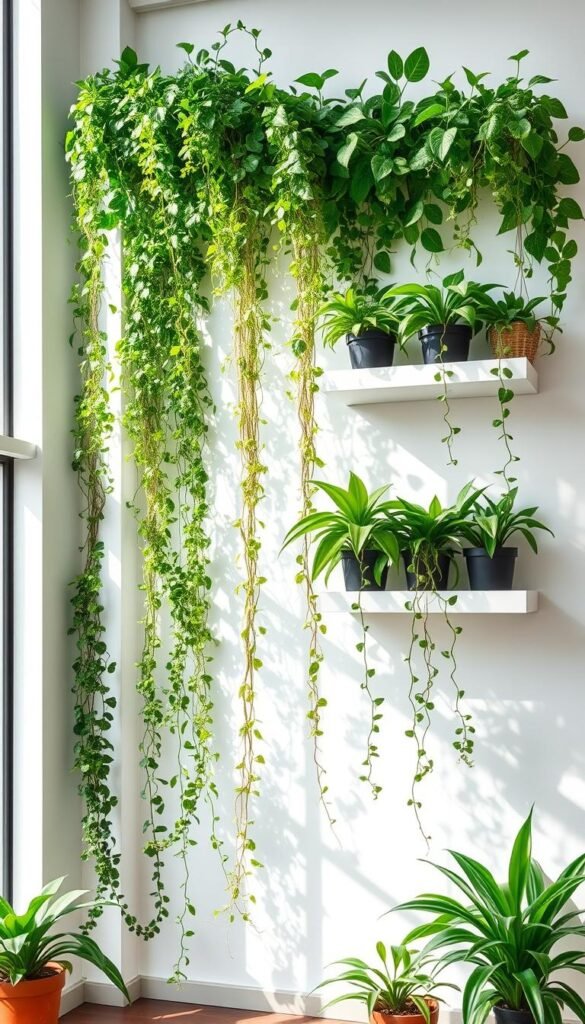
Match vertical garden design to your space. Use lightweight options like Green Living Wall self-watering systems for high ceilings, or magnetic panels on metal walls. Mix trailing and upright plants for depth—try stringing pothos alongside upright sansevieria.
Low-maintenance options include succulent grids or air plants in terrariums. For bold color, layer caladium or coleus. Most setups take 2–4 hours to assemble, with plants like spider plants regrowing from cuttings. Whether you’re targeting air quality, style, or culinary use, these ideas turn walls into thriving ecosystems.
Outdoor Vertical Garden Wall Ideas
Make your outdoor area better with outdoor vertical garden designs. These vertical garden wall ideas make walls come alive. They also adjust to the seasons and weather.
A top task for vertical gardens—especially on balconiessin urban environments—is to create privacy. An added bonus: They also bring shade.
Weatherproof Considerations
Use materials like rust-resistant metal or UV-stabilized plastics for frames. Make sure to have good drainage. The GardenWall Kit’s design includes drip irrigation.
For roots, use soil pockets in felt planters (like Jessica Welling Interiors’s setup). They stay in place even when it rains.
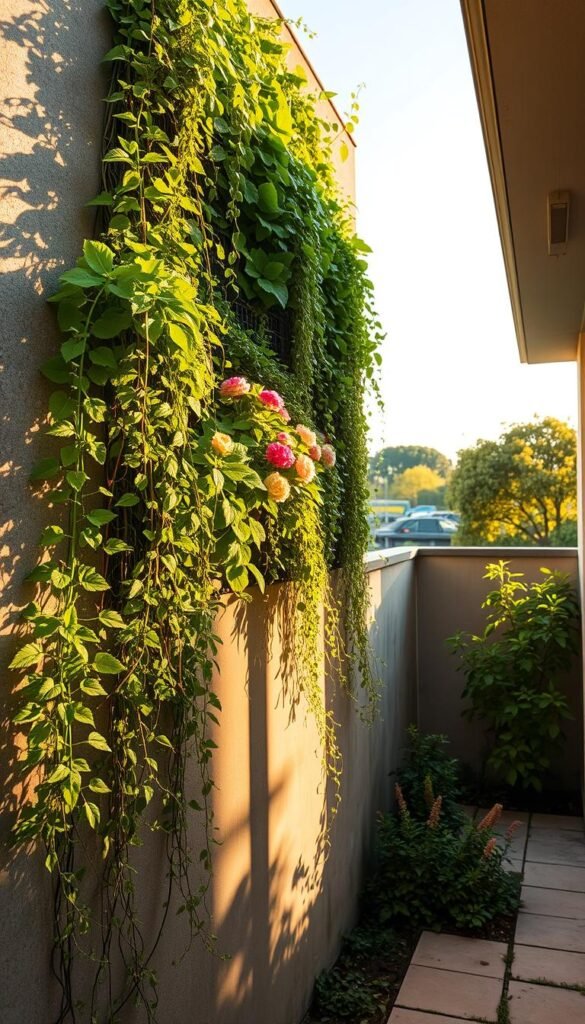
- Evergreen vines like ivy stay lush year-round in cities like NYC.
- Pair spring bulbs with summer blooms—try pansies under sunflowers.
- Winter-resistant plants like hellebores add color in colder months.
Privacy Screens and Living Fences
Use climbing plants like star jasmine or bamboo for barriers. A Succulent letter kit adds privacy with plants that don’t need much water.
Terra cotta pots on metal grids (as seen in We Heart This’s designs) frame patios. They also block views.
With the right plants and setup, your outdoor vertical garden becomes a dynamic, functional part of any space. It can soften a brick wall or screen a balcony.
The Best Plants for Vertical Garden Walls
Choosing the right vertical garden plants is key for a thriving vertical garden design. There are sun-loving plants and space-saving edibles. These picks turn walls into vibrant, functional ecosystems.
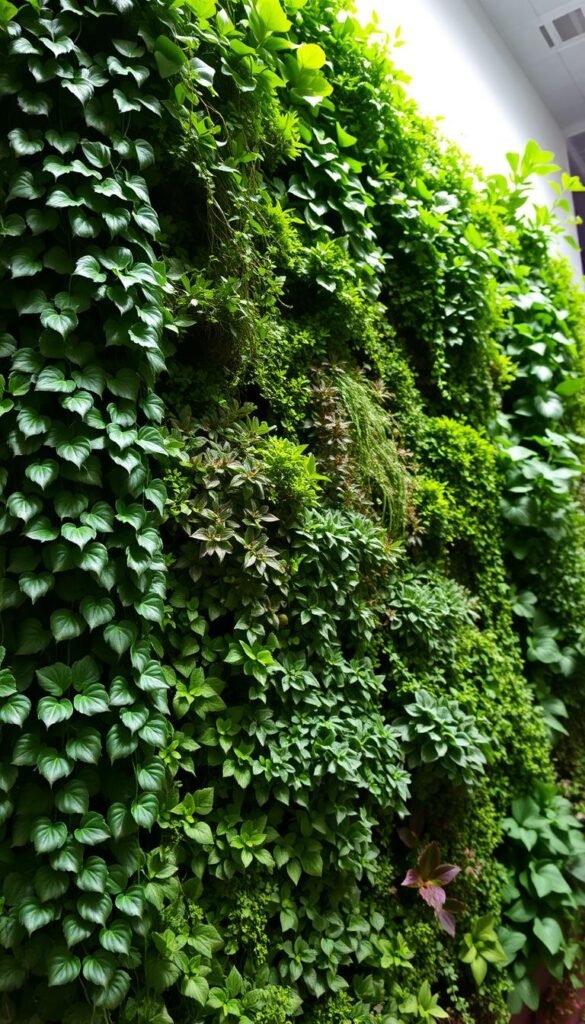
Drought-Tolerant Options
Succulents like crassula and sedum do well in dry spots. Bromeliads and hardy ferns like sword fern add texture without needing daily water. Trailing echeveria adds cascading greenery.
- Succulents (crassula, echeveria, sedum)
- Bromeliads (perfect for indoor spaces)
- Ferns (sword, bird’s nest, blue star varieties)
Flowering Plants for Visual Impact
Vertical garden design comes alive with climbers like climbing roses or clematis. Jasmine and moonflowers bring fragrance. Black-eyed Susan vines bloom a lot. For color all year, mix sun-loving plants like ‘Gardener’s Delight’ tomatoes or ‘Blondkopfchen’ cherry tomatoes.
Herbs and Edibles for Functional Gardens
Grow fresh herbs like basil, mint, and parsley in shallow setups. Vining veggies like ‘Sungold’ cherry tomatoes or ‘Dual’ peas increase yield. Cucumbers like ‘Burpee Hybrid II’ and melons like ‘Delicious 51’ do well vertically with support. Pair with oregano or sage for a culinary garden.
- Basil, chives, and mint (great for indoor spaces)
- Edibles: ‘Sungold’ tomatoes, ‘Meraviglia Venezia’ beans
- Hardy climbers: pole beans, peas, and vining squash
DIY Vertical Garden Projects for Beginners
Turn everyday items into vertical garden containers with these simple DIY ideas. Start small and let your creativity shine! Here’s how to get started:
- Picture Frame Planters: Attach a wooden box to an old frame’s backside. Fill with soil and add shallow-rooted herbs or succulents.
- Gutter Gardens: Hang downspouts or repurposed gutters on a fence. Drill drainage holes and plant trailing flowers like petunias.
- Ladder Planters: Screw metal S-hooks onto a rustic ladder. Hang diy vertical garden pots or mason jars for a tiered display.
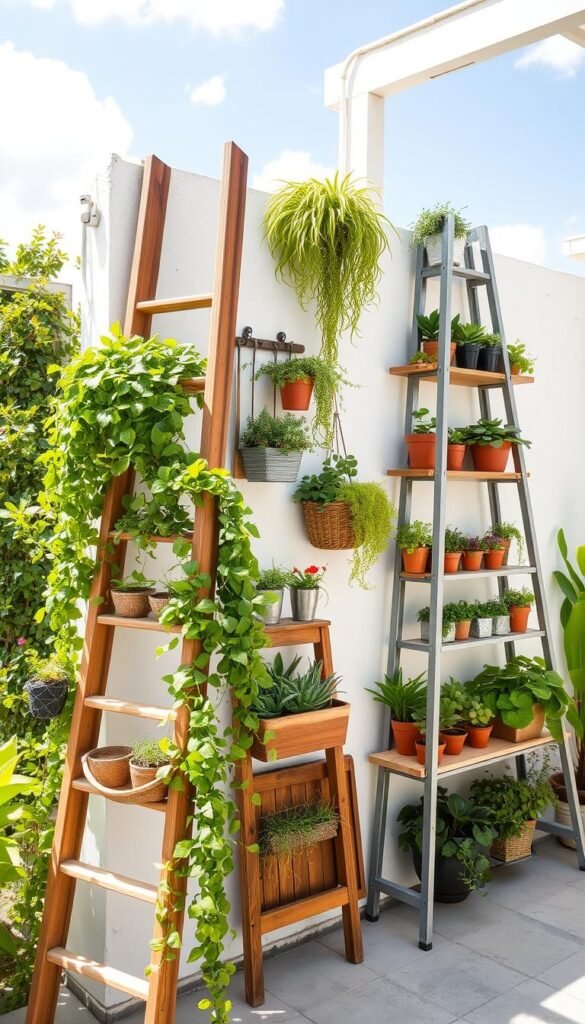
Use cost-effective materials like welded wire ($35 for 3’x50’) or chicken wire ($20 for 25’) for sturdy frameworks. Add T-posts ($4 each) for stability. You can also use recycled fencing or old pallets to save money—many can be found for free!
Beginners can start with budget-friendly tools: a Bosch cordless drill or jigsaw makes assembly easy. Add rocks for drainage, then fill with organic soil. Most projects take 2-4 hours, so don’t worry about heavy tools.
Pro tip: Match plant root depths to container size. Shallow pots are good for herbs, while deeper ones are better for tomatoes. Feel free to adjust your design as you learn—vertical gardens love experimentation!
Creative Vertical Garden Containers and Systems
Turn blank walls into green spaces with vertical garden containers. They are stylish and functional. You can use everything from old materials to commercial systems.
Our carbonized cork living wall systems were designed by experts. They keep plants healthy and growing well. We use eco-friendly materials that last for both indoor and outdoor use.
Pocket Planters and Fabric Systems
Fabric systems like felt pockets or hanging panels are flexible. They let you easily plant and water. Use them for herbs, strawberries, or plants like ivy or pothos.
Recycled and Upcycled Container Ideas
Make garden gems from old items with DIY vertical garden projects. Wooden pallets can be herb racks. Tin cans or colanders are great for succulents. Don’t forget to add drainage holes and the right soil.
- Pallets: Herb gardens or flower tiers
- Plastic bottles: Vertical herb towers
- Tires: Shallow-rooted plants like strawberries
Modular Systems for Easy Installation
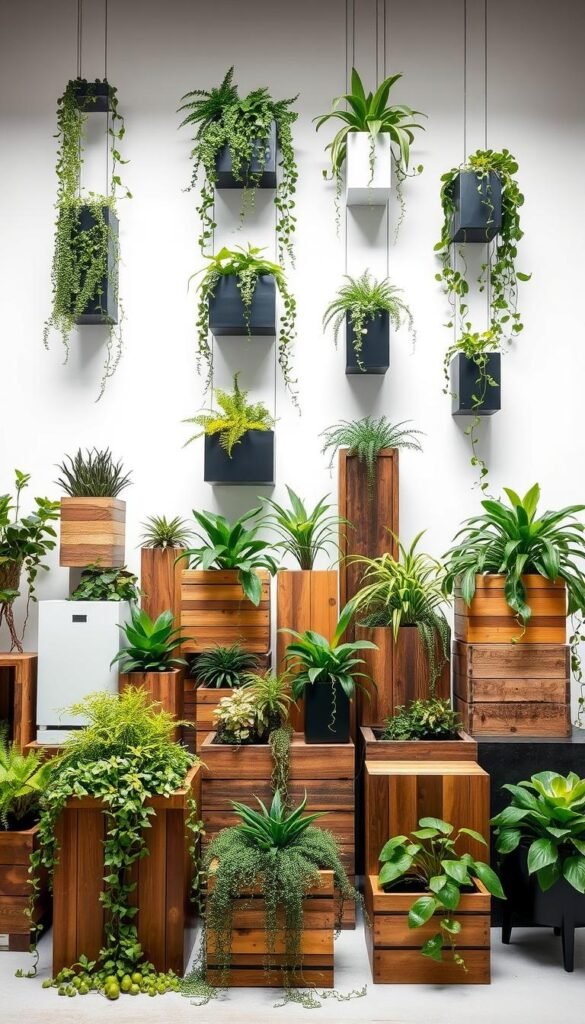
Pre-made kits like the cork system are easy to set up. They’re perfect for renters or those who need flexibility. You can attach them to walls or use freestanding towers for veggies like peas or beans.
| Container Type | Best For | Plant Examples |
|---|---|---|
| Felt Pockets | Living walls | Lettuce, herbs, strawberries |
| Wooden Pallets | DIY projects | Thyme, peppers, marigolds |
| Cork Systems | Commercial setups | Tomatoes, basil, petunias |
| Garden Towers | Small spaces | Radishes, chives, compact flowers |
Choose a system that fits your plants’ needs. Modular kits are easy to set up, while DIY options let you get creative. Start small and grow your garden as you go!
How to Build a Vertical Garden Wall: Step-by-Step
Turn your space into a green oasis with a vertical garden. Follow these how to build a vertical garden steps. First, collect materials like cedar boards, concrete, and stainless steel cables for a strong base.

“Stainless steel wire cabling systems offer modern aesthetics and flexibility for vine walls. They’re ideal for creative designs.”
Creating a Frame and Support Structure
Start by digging holes 30” deep for post bases. Make sure they’re level. Attach 6”x6” cedar posts with lag bolts for stability.
Add crossbeams using 2”x6” boards, spaced 18” apart. Vertical gardening tips suggest using galvanized hardware outside to fight rust.
- Tools needed: Circular saw, drill, wheelbarrow, trowel, gloves
- Materials: 6”x6” cedar posts, 2”x6” boards, lag bolts, concrete
Installing the Planting Medium
Mount fabric pockets or slatted panels on the frame. Fill pockets halfway with potting soil. Overlap layers for thick coverage.
For watering, thread spaghetti tubing through pockets and connect to a timer. Use wood glue and pocket hole screws for lightweight materials like trellis panels.
Planting and Initial Care
Place plants 12” apart for growth. Water well and mist daily for a week. Use a Brad Nailer for fast panel assembly.
Pro vertical gardening tips recommend choosing plants that don’t need much water for easy care.
Vertical Garden Design Principles
Effective vertical garden design turns blank walls into vibrant spaces. First, decide what you want: privacy, color, or a living art piece? Vertical garden design works best when balance and flow guide every choice.
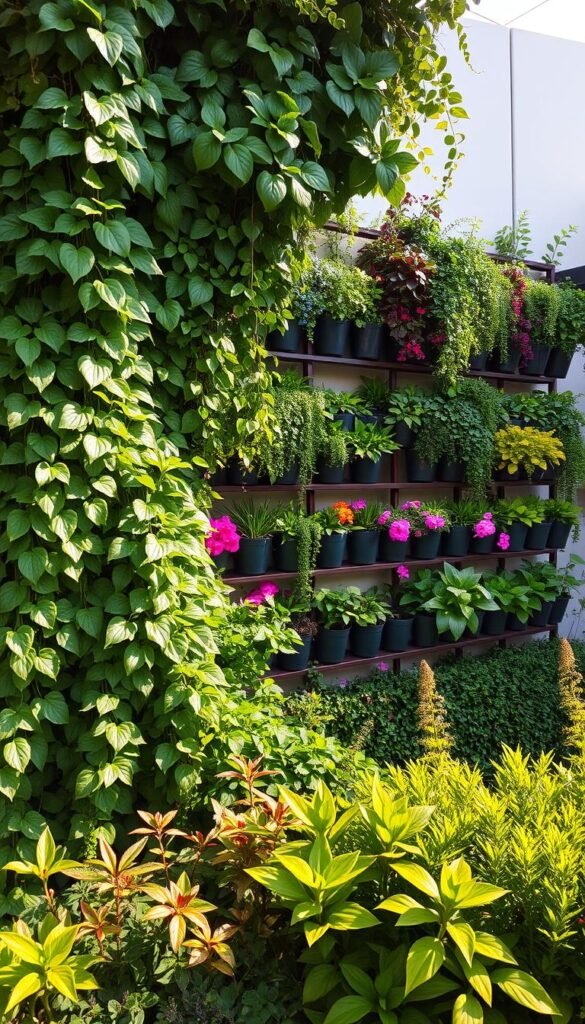
Start with the basics. Mix different textures, like smooth succulents with fuzzy lamb’s ear, for interest. Choose vertical garden wall ideas that match your home’s style. Modern homes look great with geometric patterns, while rustic ones suit wild grasses.
- Match plant needs to wall orientation. Sun-loving plants like sedums go top, shade-lovers like ferns stay lower.
- Repeat colors or shapes to create rhythm. A splash of red in clusters draws the eye upward.
- Scale matters. Use large plants as anchors, then fill gaps with smaller varieties for depth.
Modular systems like Florafelt’s recycled PET panels make setup easy. For easy care, try artificial plants like Vistafolia’s UV-stabilized ones for all-year beauty. Add LED lights to highlight textures at night.
Always protect walls with moisture barriers first. Mix edibles like herbs with ornamentals for both function and beauty. Let these principles help you create a design that changes with the seasons but stays true to its purpose.
Maintenance Tips for Thriving Vertical Gardens
Keeping vertical gardens lush and healthy requires consistent care. Here’s how to tackle common challenges:
Replacing one or two plants at a time makes upkeep manageable without overhauling the whole garden.
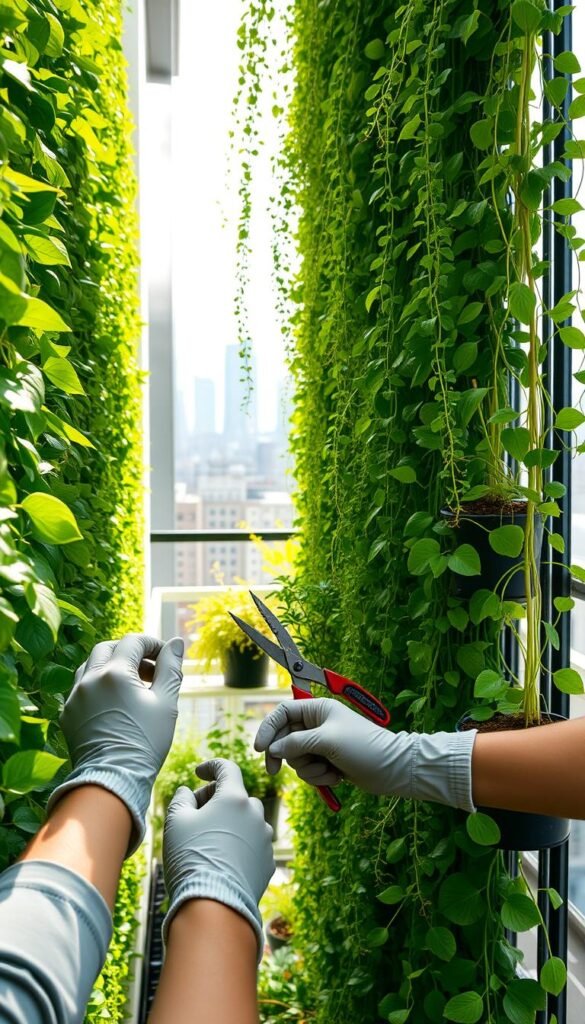
Watering Schedules and Techniques
Vertical garden plants dry out faster than traditional gardens. Follow these vertical gardening tips:
- Use drip irrigation or soaker hoses with timers for consistency.
- Water deeply but infrequently to encourage deep root growth.
- Avoid overhead watering—soak the base to reduce leaf rot risks.
Fertilization for Vertical Setups
Choose organic fertilizers like compost tea or neem oil to nurture plants without chemical runoff. Apply diluted solutions every 4-6 weeks during growing seasons. Avoid over-fertilizing to prevent root burn.
Seasonal Care and Replanting
Adjust care routines with the seasons. Here’s a quick guide:
| Season | Key Tasks |
|---|---|
| Spring | Trim dead growth and feed with slow-release fertilizers. |
| Summer | Increase watering frequency; shield plants from intense midday sun. |
| Fall | Replant annuals and mulch roots to retain moisture. |
| Winter | Cut back on watering; protect cold-sensitive plants with frost cloth. |
Pair these vertical gardening tips with the right vertical garden plants. Choose vining varieties like English ivy or herbs like basil for sunnier spots. Check soil moisture weekly and prune dead foliage promptly.
Regular inspections prevent issues before they grow. Happy plants equal a thriving wall of green!
Maintenance Tips for Thriving Vertical Gardens
Keeping vertical gardens lush and healthy requires consistent care. Here’s how to tackle common challenges:
Replacing one or two plants at a time makes upkeep manageable without overhauling the whole garden.

Watering Schedules and Techniques
Vertical garden plants dry out faster than traditional gardens. Follow these vertical gardening tips:
- Use drip irrigation or soaker hoses with timers for consistency.
- Water deeply but infrequently to encourage deep root growth.
- Avoid overhead watering—soak the base to reduce leaf rot risks.
Fertilization for Vertical Setups
Choose organic fertilizers like compost tea or neem oil to nurture plants without chemical runoff. Apply diluted solutions every 4-6 weeks during growing seasons. Avoid over-fertilizing to prevent root burn.
Seasonal Care and Replanting
Adjust care routines with the seasons. Here’s a quick guide:
| Season | Key Tasks |
|---|---|
| Spring | Trim dead growth and feed with slow-release fertilizers. |
| Summer | Increase watering frequency; shield plants from intense midday sun. |
| Fall | Replant annuals and mulch roots to retain moisture. |
| Winter | Cut back on watering; protect cold-sensitive plants with frost cloth. |
Pair these vertical gardening tips with the right vertical garden plants. Choose vining varieties like English ivy or herbs like basil for sunnier spots. Check soil moisture weekly and prune dead foliage promptly.
Regular inspections prevent issues before they grow. Happy plants equal a thriving wall of green!
Common Vertical Gardening Mistakes to Avoid

Every vertical garden project faces hurdles. Avoid these pitfalls to keep your plants healthy and your walls safe:
- Ignoring plant needs: Match plants to light, water, and space. Ferns need shade; tomatoes require 6-8 hours of sun. Research each plant’s requirements before planting.
- Over-watering: Yellow leaves or mold? Cut back. Use a moisture meter and ensure proper drainage with gravel in planters.
- Weak structures: Overloaded systems can damage walls. Choose lightweight materials and test weight distribution during setup.
- Skipping maintenance: Check plants monthly. Prune overgrowth and watch for pests. Replace one or two struggling plants at a time to avoid full garden failure.
- Forgetting drainage: Poor drainage causes rot. Add gravel layers and use pots with drainage holes. Soil pH should stay between 6.0-7.0.
| Mistake | Solution |
|---|---|
| No irrigation plan | Install drip systems or timed sprinklers. Test setups before planting. |
| Wrong soil mix | Use soil with 3-6% organic matter. Adjust based on plant type (e.g., cacti prefer sandy soil). |
| Ignoring pests | Inspect plants weekly. Use organic sprays for infestations. |
Learning from these vertical gardening tips ensures your how to build a vertical garden plan stays on track. Start small, test systems, and prioritize regular checks for long-term success.
Conclusion
Vertical garden wall ideas add life to any space, blending function with beauty. They work indoors or outdoors, letting you tailor your area. A well-chosen vertical garden can turn a small apartment into a lush oasis or a balcony into a vibrant garden.
These gardens not only look good but also clean the air and lower stress. They fit any style, from sleek to rustic, and support eco-friendly living. Start small with a DIY project or a few plants. As you get more confident, you can grow your garden bigger and more complex.
Don’t delay in bringing nature inside or outside. Dive into the vertical garden wall ideas in this guide. Let your imagination lead your design. Whether you dream of a full green wall or a small herb garden, the advantages are close. With the right strategy, your space can flourish with the energy of vertical gardening.



